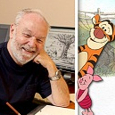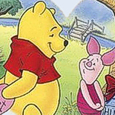Walt Disney Television Animation (February 11 2000), Walt Disney Home Entertainment (August 21 2012), Blu-ray plus DVD, 77 mins plus supplements, 1080p high-definition 1.78:1 widescreen, DTS-HD Master Audio 5.1, Rated G, Retail: $39.99
Storyboard:
The bouncy, trouncy, flouncy, pouncy Tigger finds that being the only one maybe isn’t as wonderful and fun, fun, fun, fun, fun as the song suggests, and sets out to find his supposedly long-lost family…
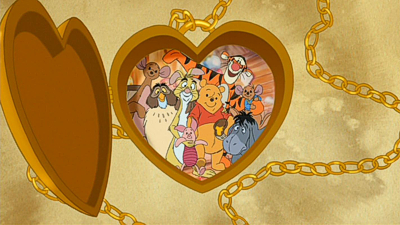
The Sweatbox Review:
Often referred to as “entry-level Disney”, the Winnie The Pooh films have always been gentler, cuter and younger-skewed kinds of entertainments. Long before the term “pre-school” became a marketing demographic, Pooh accounted for being one of the Disney Company’s biggest merchandising properties, at times second only to, and sometimes beating, the company mascot Mickey Mouse in terms of popularity and sales. Most of this turnover came from parents eager to get their children interested in the values of Disney’s animated films but also because the insanely cute Pooh and his friends were visually appealing to toddlers. Additionally, it never hurt that British creator/author AA Milne’s original characters were based on his son Christopher Robin’s own collection of stuffed animals and, long before Toy Story, Disney made sure that every child could have their own versions of the toys they saw on screen.
Since his debut for the Studio in 1966, Winnie The Pooh quickly became a mainstay, even though there was a danger that the very British whimsical nature of the stories might have been too Americanized by Disney. An early outcry (even by American critics) over the release of the first Pooh featurette Winnie The Pooh And The Honey Tree and its use of director Woolie Reitherman’s son as the voice of Christopher Robin quickly saw a renewed print replaced with a more suitable English reading (however, the stuffing of an old pedantic Beaver into Milne’s Hundred Acre Wood escaped a culling in the hastily re-dubbed version). Walt’s plan, as is now widely known, had been to produce a full-length Pooh feature after the success of the similarly British Mary Poppins a couple of years before.
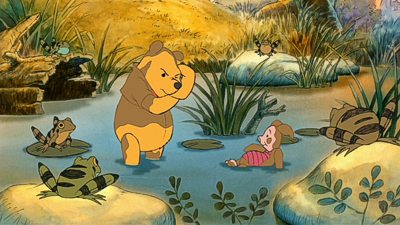
Walt was concerned that the characters were not as well known as the Poppins books, and decided to split the material up into sections and make an introductory featurette instead. Honey Tree was hugely popular with audiences and, following Walt’s passing, some of the remaining material was put into Winnie The Pooh And The Blustery Day, even more successfully winning the Academy Award for Best Animated Short in 1968. It wasn’t until some six years later that Winnie The Pooh And Tigger Too completed the trilogy of Pooh featurettes, but by now the characters were as much a part of Disney as Mickey and the gang. Finally, all three films were combined as Walt originally envisioned for the feature The Many Adventures Of Winnie The Pooh in 1977, with new interstitial animation and a touching coda providing a fully-rounded feature experience, the episodic nature of the stories not bothering the fact this was ostensibly a compilation film.
There was one final featurette, A Day For Eeyore, released in 1983 but this had been outsourced to another animation company and was mostly intended for television, where Pooh was becoming a popular character for younger children to be introduced to the wonderful world of Disney. Over the years, he has been found somewhere or other in the Disney Channel schedules, starting with Welcome To Pooh Corner in 1983. The classic featurettes were always animated in the 1960s Xerox style that so perfectly emulated the storybook illustrations come to life feel, but when Winnie first came to television the Hundred Acre Wood was populated by live-action actors in Animatronic suits! Now since apparently forgotten, Pooh Corner turned out to be a charming show that followed on from the animated Pooh and kept the childlike quality that still made the stories accessible for adults.
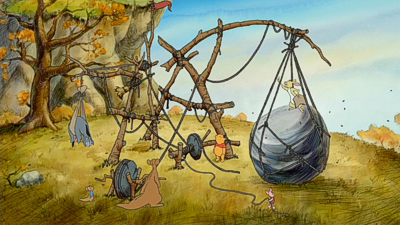
Pooh Bear returned to animation for 1988’s The New Adventures Of Winnie The Pooh, a well-remembered if not exceptional series that slotted into the kind of programming that filled the Disney Afternoons. The show proved so popular that it brought about a resurgence of Pooh animated offerings, including a series of TV and video specials, beginning with Winnie The Pooh’s Most Grand Adventure: The Search For Christopher Robin. The animation here strayed away from the “black marker” approach that much of Disney’s television animation took on at the time, even if it still failed to capture the illustrated line drawing style of the classic featurettes with only 2000’s The Tigger Movie doing a fair job of trying to nail the looser Xerox look.
One year later, the inhabitants of the Hundred Acre Wood took on their oddest appearance yet, in the puppet performed series The Book Of Pooh, but quickly returned to animation for more video releases and another television program, My Friends Tigger And Pooh, which debuted on Playhouse Disney in 2007 and proved to be an instant hit with the preschool age group, even if the purists got themselves into a bit of a fit over the conversion of Pooh to CGI and the addition of a completely new, non-Milne character, an – get this – American girl at that! Gone was the Britishness of Christopher Robin and in came what many supposed to be the brash young tones of an annoying moppet, although anyone actually watching the show will find it was arguably closer to the original featurettes in tone than anything that came after them.
I remember reading somewhere that the Pooh franchise was, even in some recent years, the Studio’s biggest earner with some $3bn made across consumer products of toys, books, television, film and video. No wonder the company wanted to keep producing new product in order to help shift the old stuff, but in the film and video arena it had to be said that Pooh was becoming a bear of very little appeal. With the purchase of Pixar, the subsequent instatement of John Lasseter to the head of Disney Animation and a desire to bring back the magic of the past, Lasseter quickly announced a new Pooh feature that would reclaim the characters as a true theatrical property and bring them back into the fold. The title said it all: this was Winnie The Pooh, pure and simple, turning the book back almost 35 years to page one and promptly discarding everything that came between the last of Walt’s originally intended adaptations and Lasseter’s reboot in order to return to the feel – and most importantly the look – of Walt’s original adaptation of Milne’s words and E.H. Shepard’s artwork.
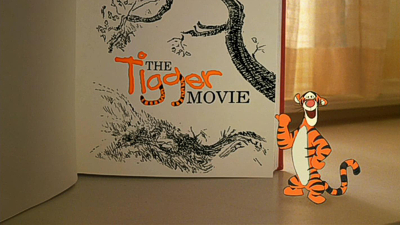
But in many ways there was at least one outing for Pooh and company that didn’t deserve to be overlooked: The Tigger Movie. The first theatrical Pooh feature since the release of The Many Adventures in 1977, The Tigger Movie was produced by Walt Disney Television Animation – hence why it isn’t included in the official Disney canon even though it feels more authentic than any of the other Pooh outings since Walt’s films. The reasons for this are plentiful, starting with the immediately noticeable visual approach that faithfully reproduces the look of the Xerox processed originals. Under director Jun Falkenstein (a rare solo woman director, who has since mostly returned to the storyboarding department on a variety of Disney and other studio films), the largely Japanese crew really manage to capture the loose lined roughness in their artwork just as much as the more recent reboot did.
Original narrator Sebastian Cabot naturally couldn’t turn up to reprise his duties, but it’s a mark of this film’s status and quality that instead of going for a sound-alike such as Laurie Main, the filmmakers went for – and landed – a customary British star in John Hurt, himself no stranger to animation after voicing Hazel in the animated adaptation of Richard Adams’ Watership Down and here bringing a nice sense of authoritative fun to his Narrator along with a bit of star wattage. As always in a Pooh movie, the Narrator gets to play and interact with the characters on the page, but there’s a little less of their bumping and fumbling with the typed text in the book they inhabit this time around, even if there are still a couple of nice moments that grown ups can appreciate in their execution.

As opposed to the other Pooh movies, it seems Milne’s stories have been overlooked here, without any specific elements having been drawn from them for this film’s feature-length plot, The Tigger Movie swapping the episodic nature of The Many Adventures and the later Winnie The Pooh to offer a single narrative throughout its length. Here, as the somewhat inappropriate non-literary title (shouldn’t it be The Tigger Book or at least The Tigger Story?) suggests, it’s all about Tigger, with the stripy one feeling a little lost as the only one of his kind among his friends in the Hundred Acre Wood. Various encounters ensue, before our bounce-a-rrific friend finds that although he’s the only Tigger, that doesn’t mean he doesn’t have a family, with a typically warm-hearted conclusion in which eventually everyone becomes Tiggers, too (something the sleeve does well to spoil)!
However, without the episodic plotting in place (where, in other Poohs, a situation arises and it is resolved, usually by accident, before another situation comes along) The Tigger Movie perhaps slightly loses the spontaneity of knowing something new will be happening around the corner. The family-finding story doesn’t always grip, with several moments feeling close to filler, while the only thing visually elaborate to come close to rivaling Heffalumps And Woozles in The Many Adventures’ Blustery Day segment is the multi-Tigger Round My Family Tree sequence. But it’s all drawn with a lovely throwback to the Xerox look and Toby Bluth’s delicate watercolor background designs are well in keeping with the originals; the simple, appropriate animation recalling the slightly more uncomplicated approach that the best Pooh films have always had.
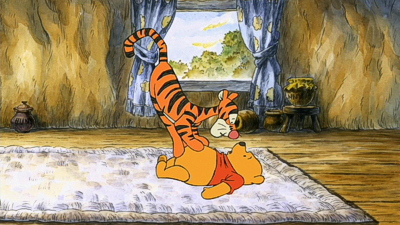
There were some grumbles about the new roster of voices drafted in to perform some of the characters in Lasseter’s more recent reboot, but whatever else one could say about the years’ worth of Pooh animation to come before it, no-one can argue the voices weren’t in keeping with tradition, and this is especially true of The Tigger Movie. Mostly this is because the characters are all still being voiced by their original vocalists: Jim Cummings has been the bear of very little brain for a while now, since long before Sterling Holloway went on to that big honey pot in the sky in the 1990s, and John Fiedler reprises his Piglet’s sweetness as only he can. The legendary Paul Winchell, although then still around to provide Tigger’s bouncy tones, was said to have been deemed too old to perform, although he did go on to voice a theme-park attraction later, and so Tigger is brought to life here by Cummings, who does – and continues – to do an authentic job.
Also helping the authenticity are the film’s songwriters – none other than the Disney Studio stalwarts the Sherman Brothers, making a more than welcome return to their spiritual home after the almost 30 years had passed between their last movie assignment for Bedknobs And Broomsticks. “Walt’s Boys” found themselves the unpopular victims of what could only be jealousy after the Mousetro’s passing, and were increasingly unused since that time. Work for other studios (Chitty Chitty Bang Bang, Charlotte’s Web), and a little for the theme parks, kept them going before Tigger (and the debut of a hitherto unheard second verse of his signature song) bounced along, although their Disney reputations would be confirmed by becoming recognized Disney Legends and consultants again for a number of home video supplemental projects.
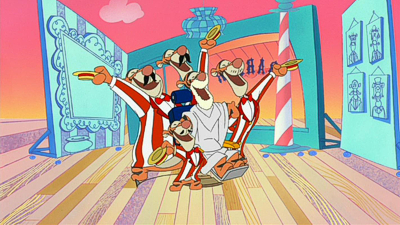
Here the songs aren’t quite premium-grade Sherman (and, strangely, there’s no Winnie The Pooh Theme reprise although this could be because its supposed to be Tigger’s movie), but there’s a warmth and magic inherent in their words and music that’s often missing in other Pooh outings. They even had something of a minor chart hit for the movie, collaborating with Kenny Loggins for the film’s signature theme Your Heart Will Lead You Home, genuinely one of the best Disney anthems to come from the Studio in recent times. Adding his own mark to the music is another big animation name, Harry Gregson-Williams, mostly known for his DreamWorks and action blockbuster scores, but here providing a lovely antidote to that with a mixture of relaxed and boisterous cues that only assist in making The Tigger Movie nothing other than a purely classic Pooh film in the true tradition.
Tigger’s successful run in theaters led to a slew of less artistic Pooh features, most of them nothing more than television-style episodes stretched out for release as direct-to-video movies, with some blown up to big screen proportions (Piglet’s Big Movie, Pooh’s Heffalump Movie), but by the time of Pooh’s Heffalump Halloween Movie it seemed that even the spin-offs were getting their own spin-offs, and it was understandable why Lasseter would want to reassert a quality level on the franchise with the release of the Winnie The Pooh reboot in 2011. But while that movie was a return to quality animation, some of the magic of the characters themselves seemed missing, something that The Tigger Movie manages to get just right while also providing the same animation aesthetic as Walt’s originals. In many was, The Tigger Movie is the Pooh feature we had all be waiting for!
Is This Thing Loaded?
Released twice to DVD in the past, in an initial almost bare bones vanilla disc and a later tenth anniversary special edition that wasn’t so special, The Tigger Movie is the supposedly second-tier animated Disney movie that proved so popular that it keeps returning to home video with the respect usually reserved for the Studio’s bigger guns. That’s, really, a delight to see, especially on the heels of the release of the more recent Winnie The Pooh reboot when it looked like Disney might have closed the book on the previous quasi-Pooh features. Here it gets the full treatment, in a Blu-ray and DVD Combo Pack that debuts the movie in HD for the first time.
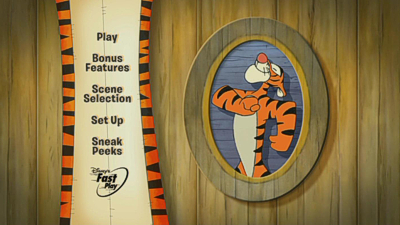
There isn’t too much to get all bouncy about in terms of bonus features, but a welcome surprise is the HD documentary featurette A Tigger Tale in which the filmmakers briefly but brilliantly chat about their experiences working on the film over a roundtable discussion. Joining director Falkenstein is songwriter Richard Sherman, whose genuine bounciness knows no bounds and who explains the genesis of the Disney Pooh from the initial featurettes in the 1960s, while art director Bluth, animator Jeff Johnson and producer Cheryl Abood elaborate on their wanting to stay true to those original films. It’s quick at just over six minutes, but that’s what makes it work: this is a very simple but appreciated (and appreciative) little piece that covers a lot of ground, including some cool 1960s/2000 comparisons, story sketches and snippets of original pencil tests. More than anything, this looks to be a brand new featurette that quite as easily could never have been made, indicating the Studio (or at least someone within Disney’s home video department!) is justly proud of the production and seemed to think it warranted this kind of extra attention – well done!

Debuting on the recent The Muppets, the amusing Disney Intermission makes a return to Blu-ray and to the Hundred Acre Wood for the first time. Automatically in effect unless deselected from the optional menu, the Intermission feature kicks into action whenever the movie is paused, featuring a mix of new, intermission-specific material mixed in cleverly with elements from the main feature including Gregson-Williams’ score. Although these randomly selected interstitial clips are variously repeated, this is again a great idea that’s been implemented very well, aiming itself as a series of fun games for younger viewers, from spot the difference, counting games and guess who’s, among others, all of it very nicely designed on, and interacting with, the “pages” of the storybook. Pausing the Intermission halts everything for real, while selecting Enter returns us to the movie.
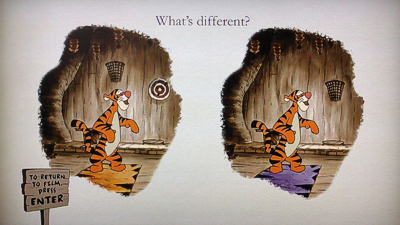
Remember those Mickey Mouse Have A Laugh spots from a couple of years ago, where classic Disney shorts were cleaned up, cut-down and re-voiced for the internet and as television filler? Well, the same trick has been applied to The Mini-Adventures Of Winnie The Pooh, first peeked at on the 2011 Winnie The Pooh feature’s disc release. Presenting moments from the original Pooh trilogy of Honey Tree, Blustery Day and Tigger Too featurettes as well as The Tigger Movie, this selected series of ten “shorts” are potted, re-voiced, re-scored and slightly rushed oddities, running around two and a half minutes each. Winnie The Pooh’s narrator John Cleese now narrates, with Cummings as Pooh and Tigger, and the rest of the 2011 Pooh cast filling in for the other characters.
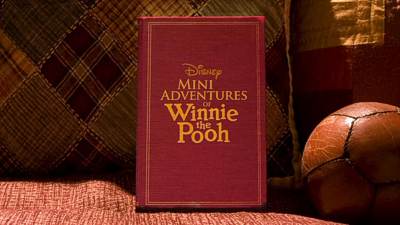
What’s weird is that around half of these Mini-Adventures merely repeat footage we’ve just seen from The Tigger Movie main feature, with alternate voice readings that just don’t sit as nicely as those heard in the film (and two of them then even reuse some of the same footage). Like the Have A Laugh spots, these TV cut-downs are pretty redundant items that don’t really have much place outside the small screen, but a plus is that that they appear to help pay towards digital restorations: the full-length featurette compilation The Many Adventures Of Winnie The Pooh will turn up soon looking exceptionally nice if these HD presentations are anything to go by.
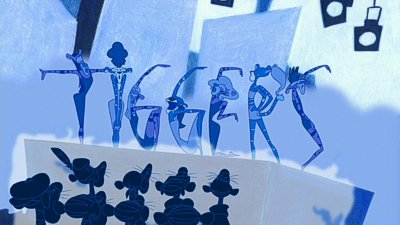
Carried over from the previous DVD editions, a Round My Family Tree Sing-Along merely plays that sequence of the movie with the lyrics of the song made visible onscreen (why not a full sing-along option for the several other songs?). The previously included theatrical trailer would have also been a welcome, but the Kenny Loggins Your Heart Will Lead You Home music video is closest we get to promotional material even if the near-five minute clip is very nicely crafted. The FastPlay enabled included DVD offers up just five of the Mini-Adventures shorts and the Round My Family Tree Sing-Along, while Sneak Peeks across both discs here promote Cinderella’s Diamond Edition, Finding Nemo’s 3D return to theaters, Tinker Bell’s Secret Of The Wings, Disneynature’s Chimpanzee, The AristoCats, The Rescuers 2-Movie Collection and Planes.
Case Study:
Making The Tigger Movie stand out from the other Disney Blu-ray titles streeting on the same day is the break away from the Studio’s usual blu-bordered slipcovers, here instead decorated in a springy Tigger-ish orange. A mild spoiler has all the characters dressed as Tiggers, giving away the film’s ending, but it’s not really as if a happy conclusion is ever in doubt and even the film’s theatrical posters featured this kind of imagery. Stickers on the embossed slipcover offer $10 off the title when purchased with another of Disney’s August 21 releases, good up to September 30 2012, as well as a peek inside: as well as the Movie Rewards code, you’ll find a lovely Family Tree Activity Kit.
This double-insert and sticker set opens up to reveal a nice background detail from the Hundred Acre Wood where youngsters can draw in members of their family to create their own tree or use stickers of the characters as substitutes (for instance, Pooh could be Dad). It’s a really nice touch that goes some way to making the package feel more substantial, and well tied into the theme of the movie. Just as good, the insert announces that Blu-ray debut for The Many Adventures Of Winnie The Pooh, set for next spring!
Ink And Paint:

Created digitally and presented in what looks to be a native 1.78:1 aspect ratio, The Tigger Movie looks every part the Winnie The Pooh theatrical film as its 1977 Many Adventures predecessor and the 2011 reboot. The cleanliness of the computer scanned line animation is still something to get used to (the Many Adventures footage on the disc still looking more hand crafted despite the digital restoration) but this is every inch a faithful reproduction of the filmmakers’ intentions, and the Tiggerrifically highlighted Round My Family Tree sequence pops out of the screen.
Scratch Tracks:
Despite its Television Animation roots, Tigger was awarded the kind of feature release treatment that the best Disney pictures receive, something that also marks it out against some of the other more recent Pooh films whose rather lackluster soundtracks missed a bit of fizz and pop. The Poohs were never the most blockbuster-heavy mixes to start with, but they never seemed “flat”, and The Tigger Movie continues that traditional primarily through the exuberant voices, bouncy songs and Gregson-Williams’ just-right score, all delivered dynamically in this DTS track. A mixture of English, French and Spanish subs and dubs (in Dolby 5.1) are all optional.
Final Cut:
Along with Disney Animation France’s A Goofy Movie, A Tigger Movie is the non-canon Disney animated feature that really does deserve a place in that line-up, even if the $39.99 list price is a little steep when bigger and more bonus-stacked Disney films have been issued at ten dollars less. The actual title might not be too correct in terms of these films’ literary lead and its contents may not borrow as wholesale from Milne as some of the other Poohs, but at its heart really is a good old fashioned trek to the Hundred Acre Wood the way we remember it from all those years ago. In the newly added documentary featurette, Intermission feature and packaging it’s nice to see the Studio seems to feel that way too, making the movie not only an easy recommend to Pooh fans but for Disney fans in general: it’s the kind of thing the Studio does best!
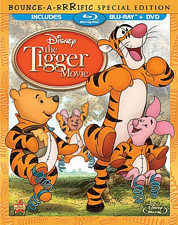 | ||
 |










